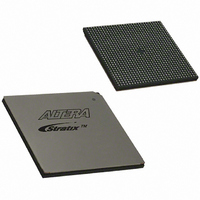EP1S40B956C5 Altera, EP1S40B956C5 Datasheet - Page 369

EP1S40B956C5
Manufacturer Part Number
EP1S40B956C5
Description
IC STRATIX FPGA 40K LE 956-BGA
Manufacturer
Altera
Series
Stratix®r
Datasheet
1.EP1S10F484I6N.pdf
(864 pages)
Specifications of EP1S40B956C5
Number Of Logic Elements/cells
41250
Number Of Labs/clbs
4125
Total Ram Bits
3423744
Number Of I /o
683
Voltage - Supply
1.425 V ~ 1.575 V
Mounting Type
Surface Mount
Operating Temperature
0°C ~ 85°C
Package / Case
956-BGA
Lead Free Status / RoHS Status
Contains lead / RoHS non-compliant
Number Of Gates
-
Available stocks
Company
Part Number
Manufacturer
Quantity
Price
Part Number:
EP1S40B956C5
Manufacturer:
ALTERA/阿尔特拉
Quantity:
20 000
- Current page: 369 of 864
- Download datasheet (11Mb)
Introduction
TriMatrix
Memory
Altera Corporation
July 2005
S52003-3.3
f
Stratix and Stratix GX devices feature the TriMatrix™ memory
structure, composed of three sizes of embedded RAM blocks. TriMatrix
memory includes 512-bit M512 blocks, 4-Kbit M4K blocks, and 512-Kbit
M-RAM blocks, each of which is configurable to support a wide range of
features. Offering up to 10 Mbits of RAM and up to 12 terabits per second
of device memory bandwidth, the TriMatrix memory structure makes the
Stratix and Stratix GX families ideal for memory-intensive applications.
TriMatrix memory structures can implement a wide variety of complex
memory functions. For example, use the small M512 blocks for first-in
first-out (FIFO) functions and clock domain buffering where memory
bandwidth is critical. The M4K blocks are an ideal size for applications
requiring medium-sized memory, such as asynchronous transfer mode
(ATM) cell processing. M-RAM blocks enhance programmable logic
device (PLD) memory capabilities for large buffering applications, such
as internet protocol (IP) packet buffering and system cache.
TriMatrix memory blocks support various memory configurations,
including single-port, simple dual-port, true dual-port (also known as
bidirectional dual-port), shift-register, ROM, and FIFO mode. The
TriMatrix memory architecture also includes advanced features and
capabilities, such as byte enable support, parity-bit support, and mixed-
port width support. This chapter describes the various TriMatrix memory
modes and features.
Table 2–1
TriMatrix memory.
For more information on selecting which memory block to use, see
AN 207: TriMatrix Memory Selection Using the Quartus II Software.
summarizes the features supported by the three sizes of
Stratix & Stratix GX Devices
2. TriMatrix Embedded
Memory Blocks in
2–1
Related parts for EP1S40B956C5
Image
Part Number
Description
Manufacturer
Datasheet
Request
R

Part Number:
Description:
CYCLONE II STARTER KIT EP2C20N
Manufacturer:
Altera
Datasheet:

Part Number:
Description:
CPLD, EP610 Family, ECMOS Process, 300 Gates, 16 Macro Cells, 16 Reg., 16 User I/Os, 5V Supply, 35 Speed Grade, 24DIP
Manufacturer:
Altera Corporation
Datasheet:

Part Number:
Description:
CPLD, EP610 Family, ECMOS Process, 300 Gates, 16 Macro Cells, 16 Reg., 16 User I/Os, 5V Supply, 15 Speed Grade, 24DIP
Manufacturer:
Altera Corporation
Datasheet:

Part Number:
Description:
Manufacturer:
Altera Corporation
Datasheet:

Part Number:
Description:
CPLD, EP610 Family, ECMOS Process, 300 Gates, 16 Macro Cells, 16 Reg., 16 User I/Os, 5V Supply, 30 Speed Grade, 24DIP
Manufacturer:
Altera Corporation
Datasheet:

Part Number:
Description:
High-performance, low-power erasable programmable logic devices with 8 macrocells, 10ns
Manufacturer:
Altera Corporation
Datasheet:

Part Number:
Description:
High-performance, low-power erasable programmable logic devices with 8 macrocells, 7ns
Manufacturer:
Altera Corporation
Datasheet:

Part Number:
Description:
Classic EPLD
Manufacturer:
Altera Corporation
Datasheet:

Part Number:
Description:
High-performance, low-power erasable programmable logic devices with 8 macrocells, 10ns
Manufacturer:
Altera Corporation
Datasheet:

Part Number:
Description:
Manufacturer:
Altera Corporation
Datasheet:

Part Number:
Description:
Manufacturer:
Altera Corporation
Datasheet:

Part Number:
Description:
Manufacturer:
Altera Corporation
Datasheet:

Part Number:
Description:
CPLD, EP610 Family, ECMOS Process, 300 Gates, 16 Macro Cells, 16 Reg., 16 User I/Os, 5V Supply, 25 Speed Grade, 24DIP
Manufacturer:
Altera Corporation
Datasheet:












